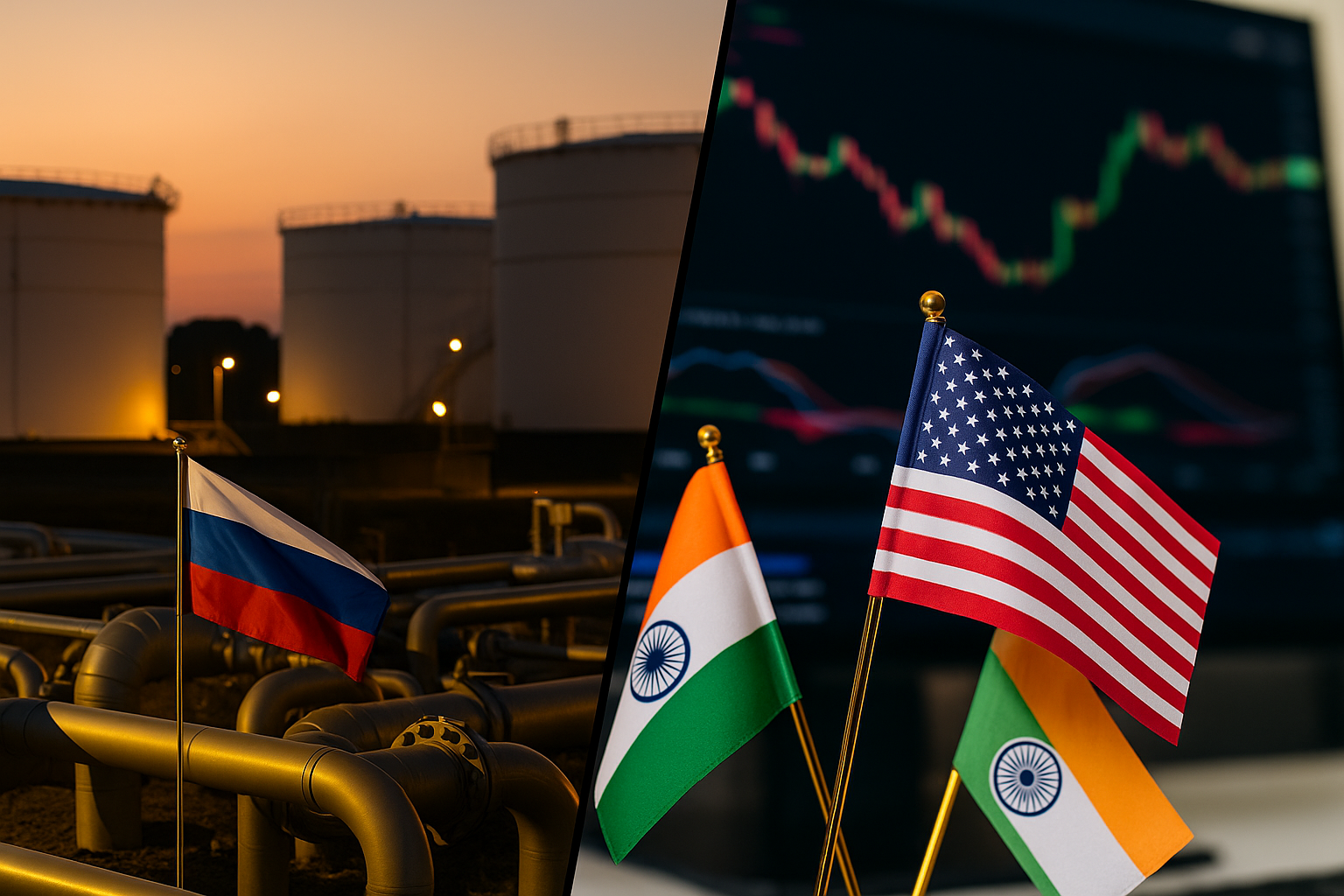Trump Sanctions Russian Oil Majors as Oil Prices Jump and India Reassesses Imports
By Tredu.com • 10/23/2025
Tredu

What Happened and Why It Matters
U.S. President Donald Trump imposed Ukraine related sanctions on Russia’s two largest oil companies, Rosneft and Lukoil. The move shifted Washington’s stance and injected fresh geopolitical risk into energy markets. Brent jumped roughly 3 to 4 percent intraday and WTI followed higher as traders priced tighter access to Russian barrels and potential financing frictions. India, one of the biggest buyers of Russian crude since 2022, signaled it would reassess imports in response to the action. Russia dismissed the impact and criticized the decision.
Immediate Market Reaction
Oil prices advanced for a second session, helped by the sanctions headline and by inventory signals in the United States. Brent traded in the mid 60s per barrel and WTI in the low 60s. Reuters highlighted a 3 percent intraday pop tied to the sanctions, with some desks noting that the move could be partly technical after recent weakness. Futures structure showed signs of firming as spot crude premiums and time spreads stabilized.
India Reassesses Russian Crude Purchases
India’s refiners, including state run companies and Reliance Industries, began reviewing exposure to sanctioned suppliers. Reliance, which had large Russian term deals, was reported to be preparing to cut or halt purchases that fall under the new restrictions in order to protect dollar market access and banking lines. The Indian government has encouraged compliance while it weighs broader energy security options. Any measurable pullback from India would affect Russian flows and global trade routes.
Moscow’s Response and Escalation Risk
Russia rejected the U.S. action, framed it as hostile, and vowed to adapt. Senior Russian officials used sharper language, with former president Dmitry Medvedev calling the steps tantamount to an act of war. While that rhetoric is not new in the sanctions cycle, it raises the communication temperature and keeps the risk premium alive.
What The Sanctions Target
The measures hit Rosneft and Lukoil as entities and tighten secondary pressure on institutions that transact with them. The design seeks to restrict financing and trading relationships that deliver cash to the Kremlin’s budget. Past rounds often forced deeper discounts on Russian barrels rather than outright volume losses. The new action is broader and could be felt more in credit, shipping insurance, and settlement.
How This Could Flow Through the Oil Market
Market impact typically arrives through three channels. First, price. A headline pop is common when sanctions expand, particularly if major producers are named. Second, differentials. Discounts on Urals or ESPO versus Brent can widen if buyers demand compensation for compliance risk. Third, logistics. Cargoes may reroute, contracts may be novated to intermediaries, and payments can slow as banks reassess risk. Analysts caution that Russian output has been resilient through past restrictions, which tempers the probability of a sustained rally unless flows are directly impaired.
India’s Strategic Calculus
India has balanced affordable supply with diplomatic constraints for more than two years. Reports indicate that state refiners and Reliance are reviewing exposure to sanctioned entities to reduce compliance risk. If Indian buying rotates toward non sanctioned Russian sellers or alternative origins, trade flows will adjust. If Indian volumes fall meaningfully, Russia will lean harder on China and other Asian buyers, likely at deeper discounts, while India increases Middle East or Atlantic Basin intake. The market will watch for any evidence that India’s refiners seek temporary exemptions or shift to third party routing.
Broader Policy Context
The decision followed a stall in peace diplomacy and new Russian strikes in Ukraine. U.S. policy now aims to increase economic pressure while Europe debates how to use frozen Russian assets. Markets will track whether Brussels adds complementary measures and whether the U.S. Treasury issues clarifying guidance on permissible transactions for non sanctioned subsidiaries and service providers.
Implications For Investors
Energy equities with leverage to spot differentials and refined product margins can see two way volatility. European and U.S. integrated oil companies benefit from firmer benchmarks but face policy headline risk. Shipping and trading names may capture wider spreads if rerouting persists. On the macro side, higher crude prices can nudge inflation expectations and complicate the path for central bank easing if the move holds. For India assets, a prolonged reduction in discounted Russian barrels could lift input costs for refiners, which may pressure margins unless product cracks compensate.
What To Watch Next
- Concrete guidance from India’s government and the scale of any reductions by state refiners and Reliance.
- Russian crude discounts relative to Brent in physical markets, along with spot premiums in Asia.
- Bank and insurer stances on transactions with sanctioned entities, which determine the friction level in trade finance.
- Any European follow on measures regarding Russian assets or energy trade.
Risk Scenarios
A sharp enforcement push that tangibly curbs volume would support a larger and stickier price move. A softer approach that mostly widens discounts would keep oil range bound but volatile. A Russian tit for tat involving export rules or shipping could strain specific grades or routes. An Indian decision to maintain higher purchases through workarounds would compress the price impact, although financing risk could still rise for counterparties.
Bottom Line
Trump sanctions Russian oil majors as oil prices jump and India reassesses imports. The headline raises the geopolitical risk premium and increases friction in financing and trade, yet past experience suggests flows can adapt through discounts and rerouting. The core theme is simple. Policy pressure rises, prices lift on impact, and the lasting effect depends on how India responds, how banks enforce the rules, and whether volumes are actually curtailed over the next several weeks.

How to Trade Like a Pro
Unlock the secrets of professional trading with our comprehensive guide. Discover proven strategies, risk management techniques, and market insights that will help you navigate the financial markets confidently and successfully.


